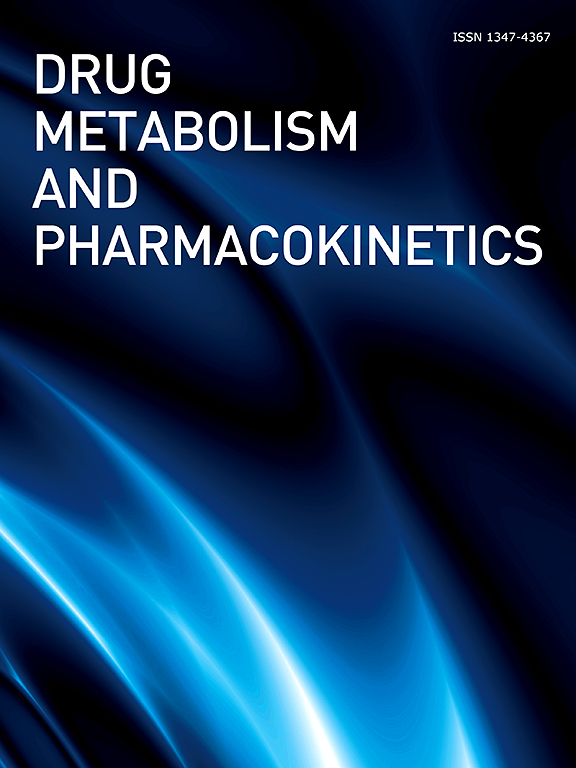Construction of refined CYP2D6-Template system for studies of its metabolism and inhibition
IF 2.2
4区 医学
Q2 PHARMACOLOGY & PHARMACY
引用次数: 0
Abstract
The previously reported Template system for the prediction of human CYP2D6-mediated reactions (Drug Metab Dispos 40 486-96, 2012) has been refined with the introduction of ideas of allowable width, Trigger∗-residue and the residue-initiated movement of ligands in the active site. These ideas are in common with published Template systems for human CYP1A1, CYP1A2, CYP2B6, CYP2C8, CYP2C9, CYP2C18, CYP2C19, CYP2E1, CYP2J2, and CYP3A4/5/7 (Drug Metab Pharmacokinet 2016, 2019, 2020, 2021, 2022, 2023, and 2024, Food Safety 2024). Total 616 reactions of 441 distinct chemicals reported as CYP2D6 ligands were examined in the refined CYP2D6-Template system. From their placements on the refined Template and rules for interaction modes, verifications of good and poor substrates, regio/stereo-selectivity, and inhibition became faithfully available for these ligands. A comparison of the placements suggested key interactions with Shelf and Left-end for ligand accommodations on the refined CYP2D6-Template. Shelf-surrounding of ligands was also proposed as a cause of their intense inhibitions. The refined CYP2D6-Template system will thus offer reliable estimations of this human CYP catalyses toward ligands of diverse structures, together with their deciphering information to lead to judgments of regioselective metabolisms.
精制cyp2d6 -模板体系的构建及其代谢和抑制研究
先前报道的用于预测人类cyp2d6介导反应的模板系统(Drug Metab Dispos 40 486-96, 2012)已经通过引入允许宽度,触发*残基和残基引发的配体在活性位点的运动的想法进行了改进。这些想法与已发布的人类CYP1A1、CYP1A2、CYP2B6、CYP2C8、CYP2C9、CYP2C18、CYP2C19、CYP2E1、CYP2J2和CYP3A4/5/7模板系统相同(Drug Metab Pharmacokinet 2016、2019、2020、2021、2022、2023和2024,食品安全2024)。在精炼的CYP2D6-模板体系中,共检测了441种不同化学物质作为CYP2D6配体的616种反应。根据它们在精制模板上的位置和相互作用模式的规则,这些配体的良好和不良底物、区域/立体选择性和抑制性的验证变得忠实地可用。放置位置的比较表明,在改进的CYP2D6-Template上,与Shelf和左端进行配体安置的关键相互作用。配体的架子包围也被认为是它们具有强烈抑制作用的原因。因此,改进的CYP2D6-Template系统将提供可靠的估计,这种人类CYP催化剂对不同结构的配体,连同他们的破译信息,导致判断区域选择性代谢。
本文章由计算机程序翻译,如有差异,请以英文原文为准。
求助全文
约1分钟内获得全文
求助全文
来源期刊
CiteScore
4.80
自引率
9.50%
发文量
50
审稿时长
69 days
期刊介绍:
DMPK publishes original and innovative scientific papers that address topics broadly related to xenobiotics. The term xenobiotic includes medicinal as well as environmental and agricultural chemicals and macromolecules. The journal is organized into sections as follows:
- Drug metabolism / Biotransformation
- Pharmacokinetics and pharmacodynamics
- Toxicokinetics and toxicodynamics
- Drug-drug interaction / Drug-food interaction
- Mechanism of drug absorption and disposition (including transporter)
- Drug delivery system
- Clinical pharmacy and pharmacology
- Analytical method
- Factors affecting drug metabolism and transport
- Expression of genes for drug-metabolizing enzymes and transporters
- Pharmacogenetics and pharmacogenomics
- Pharmacoepidemiology.

 求助内容:
求助内容: 应助结果提醒方式:
应助结果提醒方式:


